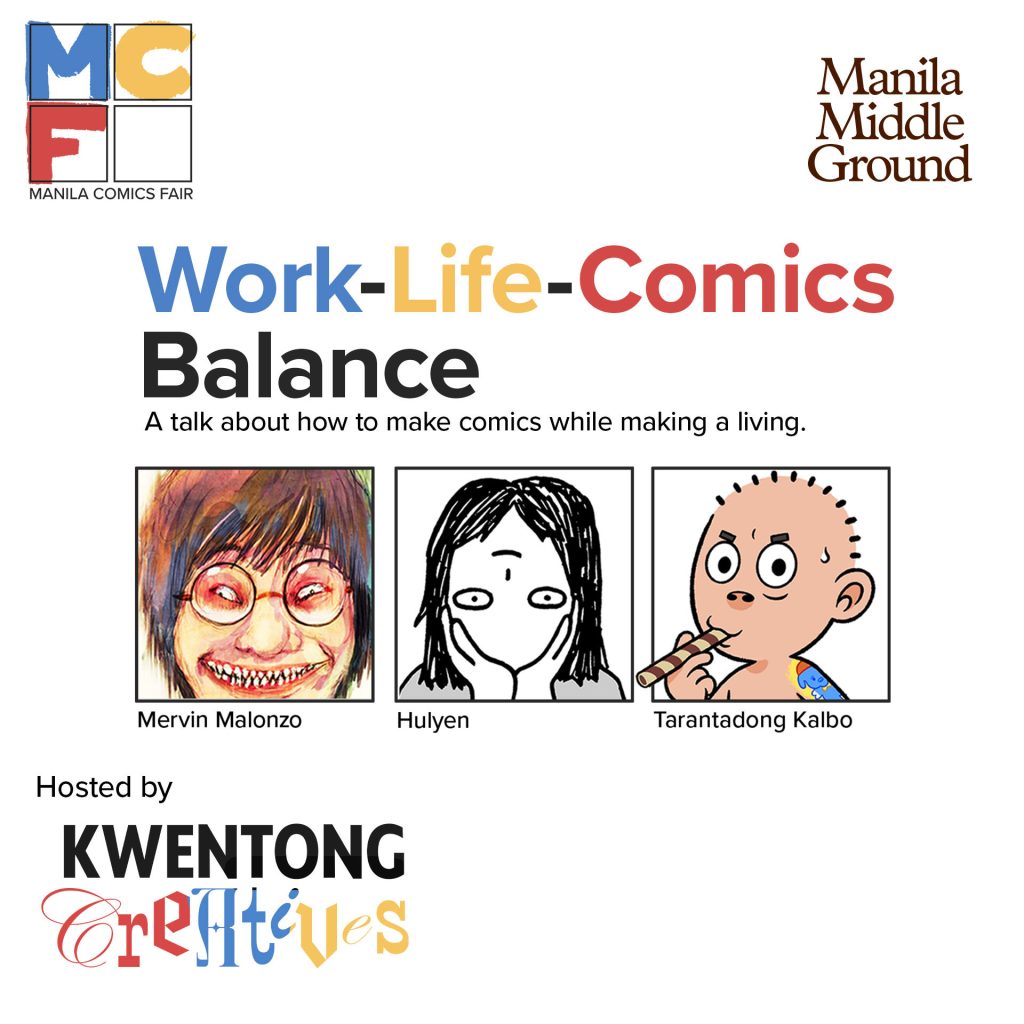MANILA, PHILIPPINES — Last year, Filipino comics creators opened up about how the industry broke them. It was part of a global conversation following the death of American creator Ian McGinty (Adventure Time, Welcome to Showside), widely believed to have been caused by overwork and underpay. The hashtag #ComicsBrokeMe opened up discussions about how making comics isn’t sustainable for most creators, and how a combination of exploitative business practices and a lack of investor confidence in the medium creates an environment where writers and artists often find themselves victims of a system where their work is simultaneously in high demand and undervalued.
It’s especially true for the Philippines, where – despite a rich history in the medium dating as far back as the legendary Francisco Coching – the number of creators today who can rely on comics as their main livelihood probably couldn’t be counted on more than two hands. Manila Comics Fair (MCF), a scrappy new expo happening on May 25, 2024 at Space63, Comuna, Makati, hopes to take a small step towards changing that.
“There’s a lot of factors against us where making a living off your comics is hard in so many ways,” shared comic book creator and illustrator Rob Cham (Light, Lost) in an exclusive interview with adobo Magazine. Together with comics artists Diigii Daguna (Mami, Cats and Where to Find Them) and Elle Shivers (Cicatrix, Pet), Rob co-founded Manila Comics Fair to not only reignite interest in local comics post-pandemic, but also to empower creators in pursuing their passions. The main thrust of the event is a series of talks and workshops featuring those who have been able to make the dream happen, including Tarantadong Kalbo (TK), Mervin Malonzo, and Hulyen.



“If it’s gonna happen, it’s gonna have to happen with us starting a way to kind of get out there,” Rob said. “I think the state of comics right now is [that] everyone’s still trying to come back from the pandemic. The cons are back, and new creators are coming out, but the industry’s kind of trying to find itself again, whether through publishing or how to push out new work.”
“Hopefully, these workshops and talks give a lot of creators tools that they can use. We’re putting some of them online as podcasts and videos for people to watch, and hopefully [as] resources that people can use to start making their own comics.”
Rob, Diigii, and Elle first met at long-running small press expo BLTX, where they all came to realize that the sense of community fostered at the event was something they’d been longing for within the local comics scene. While larger conventions play a major role in the push to make local comics a more financially viable pursuit, creators often have to pay fees to set up a table and ply their wares. And since these fees are generally higher than what an up-and-coming artist may be able to afford, the sense of community these events typically foster can sometimes give way to commerce.
“I personally have a lot of experience tabling at the bigger cons […] and I guess over the years, it has been more and more stressful, I feel, as an artist,” shared Elle. “I feel like there’s this general vibe of competition because you’re sharing the venue with like a hundred other artists.”
“I feel like with the proliferation of really really big cons or big art markets, there’s this kind of unspoken rule that what you put out there has to be extremely polished,” they continued. “You have to have a personal brand, your table setup needs to be on that brand. It needs to have tiers, it needs to have a sign, it needs to have lights, it needs to have all of those things in order to sell as an artist or participate in the scene or whatever.”
“We felt a bit lost in the comics community here, and I feel like when we all saw each other at BLTX, there was this feeling of community around comic artists, and a lot of comic artists here really want that feeling,” Diigii added.
The three soon realized that there was a need for more community-oriented events akin to Manila Illustration Fair and Type Fair PH, and geared towards connection and growth rather than straight-up selling merchandise.
Building on those conversations, Rob approached designer and illustrator Dan Matutina with the idea for MCF. Dan offered to host the event at Space63, with the cooperation of Maya via Comuna. The expo continued to take shape as Rob, Diigii, and Elle reached out to fellow creators who were eager to find that same sense of community, and some were more than happy to bring their mentorship to the table.
The first featured talk at MCF, for example, is titled “Work-Life-Comics Balance,” and promises practical advice on how to make comics while dealing with everything else in life from three individuals who’ve so far been managing to pull it off: Mervin, TK, and Hulyen. Because it’s still quite rare for local creators to treat comics as their main career, many talented artists and writers end up setting aside these creative passions for work that keeps the lights on. And since so many potential careers in comics are ended without even being given the chance to begin, mentors are relatively hard to come by.

That fear of financial instability, coupled with scarce resources on how to buck those odds, is why talks like this one are crucial to building a more sustainable foundation for the local comics industry. Creators don’t have much encouragement to even give it a try.
“I really don’t want that hesitation for this newer generation where people might be trying to share the work they do, because I feel like so much work deserves to be seen and shared,” Rob said.
At the same time, shifting the focus from selling as many comics as possible — a motivation necessary for larger conventions to support their own size — to empowering creators through lower-pressure events like MCF makes it so that more experimental and ambitious stories are encouraged. Instead of having marketability constantly at the back of their minds, comics creators are free to express themselves more fully — effectively also breaking down several mental barriers that have been holding the local industry back.
It’s a sentiment that this writer knows all too well. I once found myself questioning whether or not I should continue pursuing my dream of writing comics when, during one of my first encounters with an industry veteran, I was told that there was no money to be made in comics. The local scene is rife with that self-defeating sentiment, and it’s resulted in a mindset where creativity is ironically stymied by those charged with shepherding the industry. There is a very real sense of risk-aversion that permeates through the segments of the local comics scene that I’ve been exposed to, and that has to change if the industry wants any chance of becoming sustainable for its creators.



It starts with having more spaces that are open to ideas outside of the tried-and-tested.
“We’ve both been published by comics publishers abroad, and those have been original graphic novels,” Elle shared, referring to themself and Diigii. “But then we find it so hard to break into the scene locally, which is a bit ironic because we’re both based here.”
“There is that aspect of this like, ‘Okay I keep making work, I keep putting out work,’ but then it’s like I’m finding it hard to do anything or get it anywhere here, or get it to a certain place where a publisher locally wants to pick it up.”
“I hope that this event demystifies the process,” Diigii said. “And it doesn’t intimidate people from making their own comics, even if it’s just photocopy paper and they’re just making stuff out there without feeling like they have to make the most overproduced products, and it just inspires people to just keep making things without fear.”
“I want people to be able to not be scared to make things just because they’re not up to par with the biggest artists out there,” they continued. “We have this culture where we put artists and other people on pedestals, and I feel like if we start valuing community and start valuing people as individuals, the vibe of making comics such a scary thing starts to disappear, because now the process feels reachable and it feels like it’s democratized to everybody. I hope it’s that kind of environment that we foster [at MCF].”
Rob echoed the sentiment: “Hopefully equipping people with this and trying to help people connect allows for more interesting work. Our place in this is we’re contributing to the large contributions of everyone who ever loved comics in the Philippines, and hopefully it leads to somewhere better for future people.”
And what drives them, exactly, to try to empower Filipino comics creators in this way? According to Rob, it’s all about how local comics are intrinsically tied to the Filipino identity.
“What I love about Filipino comics the most is [that] it’s our work. It’s our stories. It’s made by us. And I feel like we’re all contributing to that language, and that should excite people,” he said.
“I hope that it excites people.”



With its focus on building a community where creators are celebrated and freely share their knowledge, Manila Comics Fair aims to provide the local comics scene with a new sense of direction: to create, to grow, and to do it all together. And with Rob, Diigii, and Elle so passionately driving the event forward, it could very well be a small step towards having — for the first time in over a century of existence — a thriving Filipino comics industry.
One, perhaps, where creators can say comics built them up rather than broke them.
The first Manila Comics Fair happens on May 25, 2024, 2:00 pm at Comuna, Makati. Along with a panel featuring Mervin Malonzo, Tarantadong Kalbo, and Hulyen hosted in partnership with Kwentong Creatives, the event will also have exhibits and tables by Anino Comics, BLINK, Avenida Books, Soup Zine Library, Ardie Aquino, Dione Kong, Sobsannix, Sneckoil, Togidemi, Maria Maranan, and Electromilk.
Adobo Magazine has declared 2024 to be The Year of Creative Sustainability, a movement to explore and recommend ways to create a more sustainable foundation for our creative industries. Learn more about adobo’s editorial direction for 2024 at this link.








